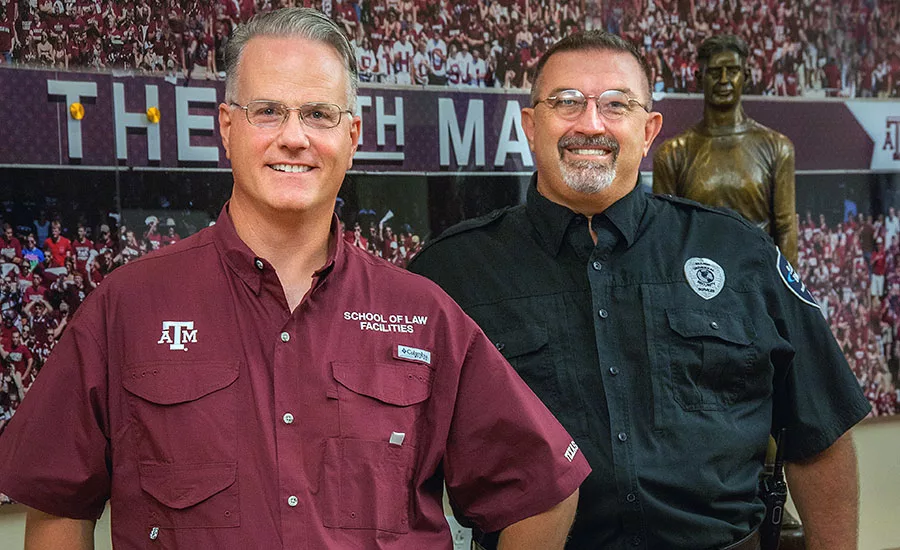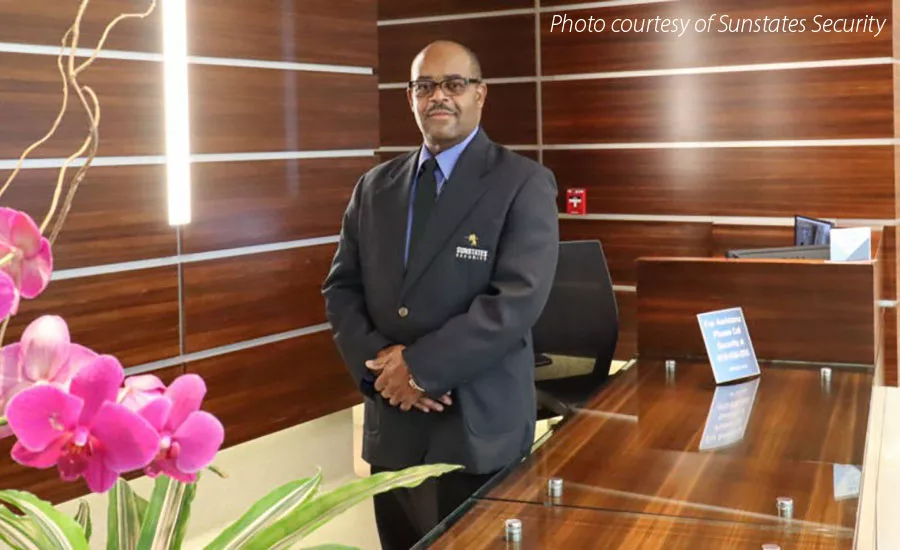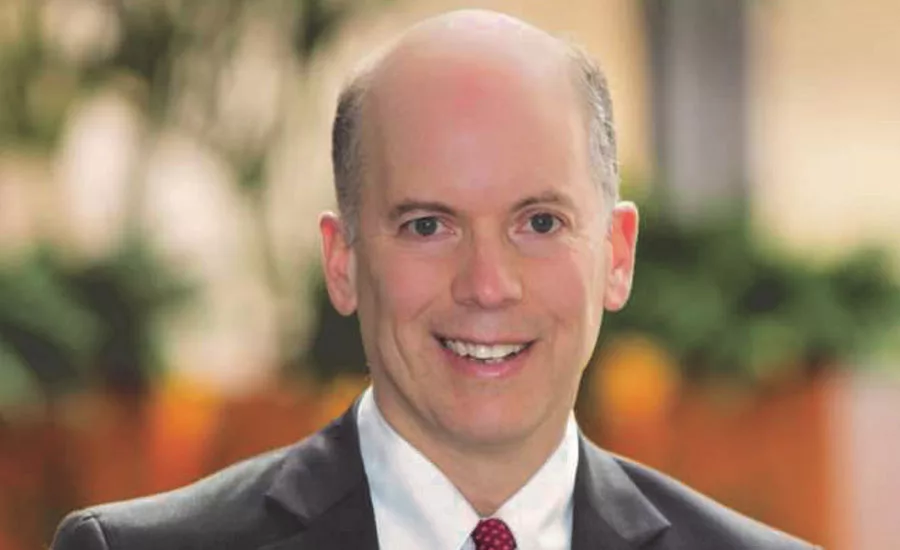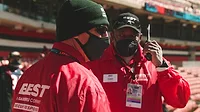COVID-19, shutdowns and unrest cascade across the guarding world
Take a look at the ebbs and flows security officers and guarding companies have weathered in 2020.

From Left: Matt Pellegrino, Facilities Manager, Texas A&M University School of Law and Eric Baze, Security Account Manager, Allied Universal Security Services.

Photo courtesy of Sunstates Security

Keith Oringer, Founder and President of Security ProAdvisors

Security Account Manager, Eric Baze, is diligently at work at their front guard station of Texas A&M University School of Law
In a typical year, guarding companies are focused on threats like active shooters, potential terrorism and natural disasters — and those concerns still remained in 2020.
But the combination of the COVID-19 pandemic, the resulting economic shutdown, and social and civil unrest surrounding the killings of Breonna Taylor and George Floyd, the 2020 U.S. election and more, were top of mind for guarding firms and impacted them in a wide variety of ways.
Pandemic and Shutdown
COVID-19 and stay-at-home mandates have meant that fewer employees are coming into office buildings and workspaces. Fewer, and in some cases zero, patrons are entering restaurants, bars, movie and music venues, and sports stadiums. In some verticals, that has meant the need for fewer guards in the first place.
But wherever people are entering buildings, for work or play, guards are often being called upon to handle unusual duties like temperature checks and enforcement of mask wearing, and they have needed protection against on-site exposure to COVID-19 themselves, notes Keith Oringer, Principal with Security ProAdvisors, which brokers mergers and acquisitions in the guarding sector.
All of this has meant the need for additional screening and PPE protocols, as well as in-depth training on these new procedures and technologies. “Deteriorated economic conditions [are] resulting in reduced guard demand and slow payment, [which] is impacting many guard firms,” Oringer says. “While staffing issues seem to be improving for many companies, the need to train guards on new policies and procedures, and supply PPE, is an ongoing concern.”
In addition, with higher numbers of workers at home, enterprises have needed to bolster cybersecurity infrastructure to mitigate attacks, which has led to chief security officers and chief information officers working collaboratively. “There is more outsourcing of security technology to the larger clients, with specialists in cyber, artificial intelligence (AI), surveillance, facial recognition, and consulting in focus and higher demand,” Oringer says.
In normal times, Texas A&M University School of Law in downtown Fort Worth, which offers Master of Laws (LL.M.) and Master of Jurisprudence (M.Jur.) degrees in addition to the standard J.D., is buzzing with activity. Located about 200 miles away from the University’s main campus in a stand-alone building, the law school hired Allied Universal a year ago to patrol its indoor facilities and outdoor parking lots.
In Allied Universal’s first weeks on the job, the U.S. Court of Appeals for the Federal Circuit and Texas Supreme Court made separate appearances at the school to hear cases. “It required a higher level of security to make sure everything went smoothly,” says Matt Pellegrino, Facilities Manager with the law school.
Given the downtown location and proximity to highways and public transportation, you never know who’s going to walk in the door, Pellegrino says, nor do you know who’s going to meander onto surface parking lots in an area with a sizable homeless population. “[Allied Universal is] managing the parking lots but also being the eyes and ears inside the building,” he says.
The level of activity in and around the building has dropped somewhat since the COVID-19 pandemic hit, although the school reopened this fall after closing in the spring. Allied Universal has needed to add a fourth guard to the mix, because, in order to socially distance classes adequately, Texas A&M has rented conference room space in a nearby hotel, Pellegrino says.
“Prior to spring break, we were very, very busy with different events, and a lot of different people coming in,” he says. “Then the pandemic came in and put the brakes on everything.” This fall, “Large classes are over at the hotel. It’s not quite as busy over here at times, as it would be in a normal semester.”
The law school has made a number of changes to access amid COVID-19, including closing off access doors to the main building to channel everyone through the front entrance; made hallways and stairwells directional; limited elevators to two people; and also made masks mandatory. Pellegrino notes that the guarding staff is responsible for politely but firmly enforcing all of those new changes.
Hewlett Packard Enterprise, based in San Jose, Calif., has contracted with Securitas since 1986 and made the company its sole provider globally in 2019. Ofir Rosenblum, Global Head of Security Field Operations based in Ra’anana, Israel, says he’s put a major focus around resilience programs and crisis management, especially with COVID-19 and other disruptive events.
“We do understand the criticality of organizational resilience, and the fact that this provides us as an enterprise the ability to effectively respond to such changes and sudden disruptions,” he says. “That was a big shift in state-of-mind across the organization and is a top priority for our board and senior executives.”
Rosenblum believes there is greater cooperation than ever between the corporate side, policy makers and at the field level, as evidenced in the partnership that’s formed around handling the pandemic. “From a corporate security team perspective, we definitely had to adjust our priorities,” he says. “Prior to COVID, we would focus on traditional programs like event security, travel security, and our site and facilities security. This has completely changed.”
That has meant adjusting manned guarding patterns as sites closed, while keeping in mind that bad actors are well aware of that fact. “In the past, our focus could have been on office-hours only, or outside office-hours only,” Rosenblum says. “We had to shift resources to adjust to the new reality with regard to site presence.”
Normally the company would rely on employee awareness supporting the security team, based on the idea that security is everyone’s responsibility. “Not having people in the offices, we are losing those extra pairs of eyes and ears,” he says. “Not having them on site due to site closures and lockdowns requires the skeleton, on-site manned guarding and security team to be on higher alert in responding to situations.” Officers also have needed to support health and safety activities like temperature checks, he adds.
Raleigh, N.C.-based Red Hat Software, which uses locally based Sunstates Security for its U.S.-based operations, usually likes contract guards to be interactive with associates and in turn, to be treated like they’re part of the company, says Lee Scott, Senior Manager for Global Safety & Security. But now, they’re typically the only ones around.
Red Hat Software has moved its operations center into a more open environment, so guards can social distance, while installing Plexiglas at the reception desk. “It’s become a weekend setting, 24-7,” he says. “The biggest concern we have is that they’re really there alone. We want to keep them engaged and make them feel productive. … It gets very boring around the holidays [for guards]. Imagine that 24-7, going on nine months.”
What’s Happened—and Likely to Happen—in Security M&A?
COVID-19, the economic recession and other factors have impacted the guarding market in terms of mergers and acquisitions during 2020, and will continue to do so in the coming year, says Keith Oringer, principal with Security ProAdvisors.
The pandemic and subsequent business contraction has continued the trend of capital concentration with private equity groups, and the largest public companies, which will be competing to grow both traditional guarding and the technology portions of their business, Oringer says. “Large companies and well-financed PEGs [private equity groups] are competing to acquire a limited supply of large and mid-sized guard companies, subsequent to Allied Universal’s buying spree.”
Oringer also sees a race for geographic expansion shaping up, as Allied Universal may seek to expand globally, GardaWorld and Prosegur grow in the United States, and Securitas broadens into the integration sector. Although further consolidation could still happen, in recent weeks, G4S has rejected offers from GardaWorld and Allied.
And Oringer believes there will be increased technological acquisitions to broaden and appeal to users, focusing on cyber, AI and facial recognition in particular, but also surveillance equipment, GSOC services, system integration and consulting.
Independent operators will continue to be abundant, although some may face economic strains, leaving adequate supply on the market for acquisition by smaller and regional companies, so long as they have the capital to do so, he says. And new private equity will continue to enter the contract security industry, Oringer says.
“Over the last 30 years, private equity has done very well with returns,” he says. “New security guard companies are being started all the time, and as a result the fragmentation and consolidation will continue.”
To the extent people do come into the office, the software company has been asking guards to handle temperature checks in some locations and other technology-related duties, Scott says. “You’re asking security officers now to potentially use thermal equipment, or monitor associates as they walk in,” he says. “It goes back to customer interactions and customer skills.”
That has meant changing the mentality of the guard force from a monitoring or customer care center to an analytical hub that provides feedback and information to the sales and services group about conditions around the city, and possibilities of reopening offices and enabling people to travel, Scott says. “They’ve become the support for our regional security managers,” he says.
In normal times, the Detroit-Wayne Joint Building Authority (DWJBA), which houses six branches of city and county government in respective 20- and 14-story buildings, is home to 47 elected officials, about 1,600 employees overall, and between 4,000 and 5,000 daily visitors — or around 1 million people per year.
Gregg McDuffee, executive director of the DWJBA as well as president of the Building Owners and Managers Association (BOMA) of Metro Detroit, has a 35-person security team on contract through Securitas at his disposal. This year there have been far fewer people to protect, but the structures remain even though the governmental budgets have taken an expected mid-year hit due to the coronavirus shutdowns.
McDuffee’s top concern due to COVID-19 has been maintaining a healthy workplace. “We’ve got to keep our team healthy,” he says. “The impact on our asset from the standpoint of an additional burden on operating expenses has been really severe. We’ve had, out of necessity, to do an additional amount of high-touch cleaning. … We’ve had to do deep cleaning when there’s a COVID-positive employee or visitor. We have also introduced health screenings at the employee entrance and public entrance, outsourced to medical professionals.”
The pandemic has led to significant turnover due to overall stresses, people’s challenges commuting to work and, perhaps, because of the additional unemployment money available through the federal stimulus package, McDuffee says. “We’re doing everything we can to create a very calm environment,” he says. “We’re meeting the public with a smile. That has the potential for reducing stress. People under stress can do dangerous things.”
McDuffee says he has emphasized the fact that in the face of COVID-19, the job of security personnel still remains focused on security. “That’s your primary objective,” he says. “We’re focused on the basics.”
Social Unrest
While the economic shutdown may have reduced the need for guarding for some locations, the social unrest in the wake of street-level protests that ramped up earlier in the summer, likely has and will increase the need for private security. “Employees and guards need to be fully trained on new threats due to social unrest,” Oringer says.
Red Hat Software keeps tabs on localized disruptions as well as unrest around the country and around the globe, Scott says. “There’s no telling whether someone’s protesting because the city’s shutting down or the city’s opening up, or there’s a racial or political issue going on,” he says. “We’re monitoring for those things as we would for a hurricane or another type of storm.”
The Detroit-Wayne Joint Building Authority definitely has been geared up for the possibility of civil disturbances, McDuffee says. “We’re seeing that all over the country in areas large and small,” he says. “It creates further danger [beyond COVID-19] and stress in an urban area. Where people are working remotely, getting them to come back to the workplace when things improve is going to be exacerbated” due to fears of disturbances.
McDuffee wants to make sure that during a challenging year, his security team keeps in mind the year-to-year challenges that security personnel always face. “We need to remain focused on the active shooter and the protocols for dangerous weather and fire safety,” he says. “Let’s not get distracted with the pressing challenges that are in the news all the time. I’m a big believer that if you do the basics exceptionally well, you can handle those things that blindside you, like a pandemic.”
Security Careers for Veterans
By Chris Hertig
The security industry in North America is massive. It is also complex. And steadily growing. There are more jobs and different types of jobs emerging all the time. That said, it can be called “The Invisible Empire” because so few people are familiar with it.
Military folks have an ease of entry into this industry. They have all had some exposure to the protection of assets in various ways. They have mastered the art of dynamic problem solving; something that is integral to security. Some have worked security assignments, others may have held part-time jobs in contract security while being full-time soldiers, sailors or airmen.
For those who don’t see a career in security; that’s OK. Getting civilian security employment can be a truly transitional phase of one’s career. When I was in college working security as a student, one of my fellow officers was a management major. He wanted the campus security experience to demonstrate that he could hold a position of trust and responsibility.
The industry can be easily entered at several junctures. Security service firms are continuously hiring. Employment with them can be obtained on a full or part-time basis. Licensing requirements vary widely between the states and provinces but are generally minimal. Becoming an unarmed or armed security officer is not an insurmountable challenge as it may be in some other fields (medical). Said security experience provides invaluable exposure to organizational culture and the development of soft skills. It may also initiate membership in a network which proves valuable down the road.
Networks in security can be developed through ASIS International. There are 200 plus chapters worldwide. Veterans can go to meetings and meet managerial personnel – the folks who do the hiring. ASIS also has an Appreciation Day for military and first responders at the Global Security Exchange each year. This is an excellent opportunity to view and interact with security managers and directors from a variety of organizations (corporate, non-profit, government, military).
The International Foundation for Protection Officers (IFPO) supports veterans and first responders to the greatest degree possible. There is a substantial discount on membership (a network) as well as professional certification programs (credentials). The latter are internationally recognized and COOL approved. The IFPO Career Center provides a snapshot of the security industry.
About the author:
Chris Hertig is active in several professional organizations such as ASIS International, the International Foundation for Protection Officers and the International Law Enforcement Education and Training Association. Chris is both a Certified Protection Professional (CPP) and Certified Protection Officer Instructor (CPOI) who has published extensively on education, training and career development.
Tech Trends
Beyond those media-saturated challenges, McDuffee sees an ever-greater reliance on technology but also an ever-greater need to keep technology in context. “I hear frequently, ‘We’ve got much better camera technology, which is terrific, it’s more eyes-on,’” he says. “That’s not the eyes-on. The eyes-on are the trained people monitoring.”
Rosenblum says he sees guarding units relying more than ever on technology such as access control and intrusion alarm systems, particularly with sites standing empty. An alarm going off in the middle of the day would receive far greater priority now than before, he notes. “We may also utilize technology to assist with things related to COVID-19, contract tracing and so forth,” he says. “In the case of a need to investigate close contacts, if the case is in the workplace, we will use site security technology to investigate that.”
In addition, companies like Hewlett Packard Enterprise have needed to provide training and awareness around cybersecurity for those working from home, using personal devices outside of corporate networks, to protect critical assets, Rosenblum says. And he’s seen more unauthorized use of corporate devices for personal activities online.
Red Hat Software has chosen not to bring in any new technology around COVID-19 response, focusing on repurposing current equipment, Scott says. “How can you use your visitor management system to meet some of the emerging compliance requirements from the government?” he says. “Instead of having a knee-jerk reaction, let the situation play out before making investments.”
Oringer has noticed increased use of drones to provide surveillance for large, mostly inaccessible sites like pipelines. “Robots are being used for some patrol to identify hazardous conditions, and we expect that their use will intensify as the technology has improved and becomes more acceptable,” he says.
Oringer anticipates larger guarding companies making acquisitions in the technology and consulting spaces to fill out their security programs and expertise available to customers. Smaller and regional companies are needing to focus on service, communications, and the use of tour technology to better compete with the behemoth firms. “Smaller and regional companies will need to stay focused on providing quality service, being close to their customers, and providing some level of technology in their approach,” he says.
While larger guarding firms gain national accounts with their broad suite of services, smaller accounts can be more difficult for national companies to win over, Oringer says. “Some people like to reach the owner on the phone,” he says. “At the end of the day, some clients are focused on service, [and] some are focused on price. It’s the total picture.”
Going forward, McDuffee notes that COVID-19 is not the first pandemic the guarding industry has faced — although it is the largest in a century — and it likely won’t be the last. “We’re going to see more of this going forward,” he says. “We’re going to get through this phase, but we need to have this at the forefront of our thinking. When this hits us again, and it will, we’ve got to have all this knowledge, and all these procedures and protocols available to us to respond quickly. I’ve been enormously impressed with how I’ve seen our industry respond to this.”
18th Annual Top Guarding Firms Listing
|
Firms' Head Office |
Employees |
Offices |
TOTAL |
|
Allied Universal, Santa Ana, CA |
230,000 |
225 |
8,000,000,0001 |
|
Securitas North America, Parsippany, NJ |
107,000 |
498 |
4,300,000,0002 |
|
G4S Secure Solutions, USA, Jupiter, FL |
58,575 |
207 |
2,411,000,0003 |
|
SecurAmerica, Atlanta, GA |
30,000 |
320 |
1,000,000,000 |
|
Constellis, Herndon, VA |
8,000 |
22 |
673,100,0004 |
|
Paladin/PalAmerican Security, Vancouver, BC |
16,000 |
41 |
670,000,0005 |
|
Walden Security, Chattanooga, TN |
6,200 |
17 |
305,000,000 |
|
Summit Security Services, Uniondale, NY |
5,000 |
9 |
214,000,000 |
|
Prosegur USA, Herndon, VA |
6,500 |
19 |
200,000,0006 |
|
Andy Frain Services, Aurora, IL |
15,250 |
52 |
131,750,000 |
|
St. Moritz Security Services, Pittsburgh, PA |
3,000 |
32 |
110,000,000 |
|
SunStates Security, Raleigh, NC |
3,027 |
27 |
106,530,000 |
|
Signal 88 Security, Omaha, NE |
3,500 |
120 |
99,000,000 |
|
Titan Security Group, Chicago, IL |
2,100 |
3 |
93,900,000 |
|
DSI Security Services, Dothan, AL |
4,750 |
27 |
89,000,000 |
|
First Coast Security, Jacksonville, FL |
2,500 |
14 |
85,000,000 |
|
GuardOne Security, Roswell, GA |
2,000 |
21 |
67,000,000 |
|
Per Mar Security & Research, Davenport, IA |
1,906 |
13 |
62,600,000 |
|
American Security & Investigations. St. Paul, MN |
1,500 |
8 |
59,000,000 |
|
USI Security, Red Bank, NJ |
1,500 |
12 |
47,500,000 |
|
Elite Investigations, New York, NY |
1,800 |
6 |
47,000,000 |
|
United Protective Services, Dallas, TX |
1,350 |
8 |
33,700,000 |
|
Platinum Group Security, Deerfield Beach, FL |
900 |
5 |
30,000,000 |
|
Arrow Security, Smithtown, NY |
850 |
9 |
28,500,000 |
|
Motivated Security Services, Somerville, NJ |
900 |
4 |
25,000,000 |
|
Security Alliance Group, Miami, FL |
650 |
5 |
21,500,0007 |
|
Prepared from responses from CEOs, COOs, or CFOs for the year ending 12/31/2019. Totals are rounded off. Notes: 1. Total revenues: $8.4B. Allied Universal acquired: Point 2Point, May 3/19; Shelter Security Svcs., 7/12/19; Vinson Guard Svc., 11/18/19; SOS Security, 11/21/19; and APG Security, 12/2/19. 2. Total North American revs. $5.1B; total global revs.: $11.6B. 3. Total corp. security revs.: $2.8B; total global revs.: $9.8B. 4. Total corporate revs.: $1.7B. 5. Canadian-based, acquired Criterion Security, 3/22/17. 6. Entered US market 9/18/18 with the acquisition of Command Security by Prosegur Compañia de Seguridad, Madrid, global revs. of $4.7B from security operations in 26 countries. 7. Total revenues: $26M. New this issue: Constellis, Motivated, Guard One Security (Security Solutions of America), Paladin Security, Platinum, and Signal 88. Special assistance from Security ProAdvisors and Trackforce Valient. *Special thanks to Robert McCrie, Keith Oringer and Security ProAdvisors and Jeff DiDomenico of Trackforce Valient for the information and rankings. |
Looking for a reprint of this article?
From high-res PDFs to custom plaques, order your copy today!






